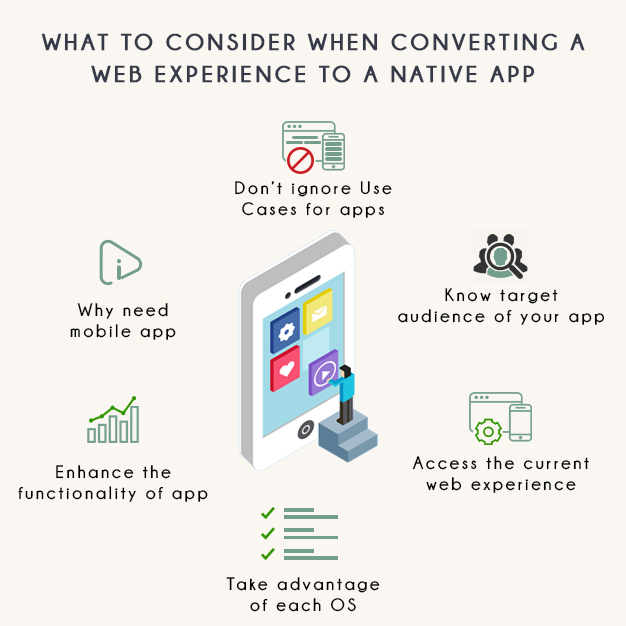What to Consider When Converting a Web Experience to a Native App
Gone are the days when everybody wants a website. Today, more and more people are looking for native apps and not web apps. It has become an important factor for companies to convert their websites to mobile apps.
There is a great increase in the potential to reach customers through their phones. Mobile technology has taken over the world and it is likely that companies who do not invest in mobile apps will become obsolete in future. It is equally important to invest wisely in mobile apps, as it is not enough to just have a mobile app. The mobile app has to make sense and should provide value to the customers to drive effective results. If the app backed by the brand is of not much use, it builds a negative image of the brand.
There are thousands of companies that only have a web app or web experience. They are yet to create a native app that can be distributed on Android and iOS play store to reach new people as well as provide additional value to existing customers. If you want to move ahead of your competitors, it is must to convert web app or web experience to a native app. However, it is not easy to do as there are a number of factors to consider while converting web experience to native app.
In this post, we have made a list of factors to consider when converting a web experience to native app.
Before that let’s see what does native app mean? What are the pros and cons of native apps over web apps?
What are Native Apps?
A native app is the one that is built for specific platform such as – iOS, Android, Windows etc using their hardware features and libraries. On the other hand, a web app is the one that is hosted on web and accessed from the browser of mobile device.
Native apps perform faster compared to web apps and allow easy access, regardless of the location. Interfacing with the features and functions of mobile device is the strength of native apps. The key benefits of native apps are as below
- Storage
Native apps can run asynchronously i.e. the data can be stored on the phone and synced with central web server. Native apps are ahead of web apps, as new features and technologies allow it to be done in mobile based environment.
- Speed
The code to run the native app is stored locally on the phone and hence these apps tend to be responsive and faster. Users need not to wait for the content to be downloaded from the web, which is a great improvement over web-based apps.
- Features
Native app approach gives you access to the information allowing interesting functionalities such as – accessing GPS information, leveraging NFC, taking photos etc. On the contrary, web apps are browser-dependent, and do not have any access to the features of device.
Though native apps have many benefits over web-based apps, there are a few drawbacks too. The main drawback is that the developer needs to create and maintain a separate code on each platform. For instance – if the app was developed for Android platform, it has to be designed, coded and deployed on iOS platform separately.
Both the approaches have their share of pros and cons. Which approach is “better” will depend on the desired functionality and availability of resources. A long term strategy would seem to favor native apps, provided by a well-orchestrated user experience.
Factors to consider when converting web app to native app
Deciding between a mobile app or web app is a big decision. It is important to consider different factors related to your business. Look at the current priorities and where you want to be in future before you think of converting a web app to native app.
- Know why you need a mobile app
Users are more concerned about their experience with the company. If the user ever had a bad experience with your company, he/she is likely to go elsewhere. Many companies start with web and then go to mobile apps. It is up to you how you want the cross-platform experience to be implemented across different platforms.
Make sure that the mobile app is capturing all the website features. You can even incorporate a few important features in the mobile app, instead of all the features of web app. Try to add a unique feature that does not exist in the web app.
- Access the current web experience
Spend some time analyzing the existing website and take a look at what is working and what is not. This will not only help you understand the existing website, but will help you gather ideas for enhancing web experience. For example – if you have an online grocery store that allow user to prepare weekly grocery list, think whether you should incorporate the same features or offer something different?
Many reputed companies started with a website, then a web app and eventually created a full native app that has some core features of the website. Companies should optimize existing features of the app, instead of and services. This will allow users to stay connected with the company from their device.
- Don’t ignore Use Cases for apps
Though the users like to use apps, there are chances the same user interacts with the website. They may use the native app or website based on their requirement and location. The user expectations and sense of urgency will be different when the user uses native app.
Therefore, it is important to consider the use cases that come with apps. You can ensure of delivering great user experience by thinking of how, when and where the audience will use the app. No doubt, great apps are delightful to use and there are a few common cases across great apps. If you want your app to be held at same standards, it is must to meet app design expectations.
- Know target audience of your app
If you already have a website, you are aware of your target audience. You have to analyze if the same people are going to use your app. As you assess your website, you will know that you are missing a group of potential users and how they want to interact with your company.
There are a number of webmaster tools that help you know what devices people are using to access your website. Using these tools, you can know the target audience of your native app.
- Enhance the functionality of app
It is not essential to incorporate all the features of your website into the app. Companies should focus on identifying the must-have features based on the app requirement, use cases and target audience. Companies with extensive web experiences have multiple native apps with different functionality and enhanced user experience.
The functionality of your app is likely to take advantage of device specific functionality provided by different devices such as – smartphones, tablets, etc. It is must to assess how the user is going to interact with the feature of native app. There is no reason to add them, if they don’t help the user accomplish their goals. Native apps have a unique look and feel, and hence the UX of the app should be entirely different from website UX.
- Take advantage of each OS
Every mobile OS has different features that can take your native app to the next level. Don’t afraid to use the native features of each OS, as they enhance the user experience of the app. Apps are better way to attract new users and engage existing users.
When it comes to deliver seamless and robust user experience on mobile, native apps dominate web apps. However, there are some serious consequences during the process of converting the app. Converting the web app to a native app without considering the above factors will not only the spoil the reputation of the company, but wastes the development costs.
As you are in the process of converting your web app into native app, you will have an opportunity to examine the features, content and overall experience from time to time. Add message throughout the website about the new app. If you check websites of some of the reputed apps, you will find that they have a wide range of marketing materials such as – app banners, badges etc.
It is important to measure and analyze what is working, once the app is released. Remember that the features you added in your app won’t work the same way for your web experience. The native app may change the entire web experience. Start with an app that does a few things, and add more features gradually.
Wrap Up!
Native apps can offer great operational efficiency that websites often do not. Moving from a website to native app is not just a matter of replicating what you already have on web. It is all about crafting the app that goes beyond your website. Take time to understand how users use the existing website and how the native app is going to help them. By converting a web experience to native app, you are improving the way your users interact with your company.
If you are not sure how to convert your website to mobile app, you can contact a reputed mobile app development company. They are always ready to assist you and give professional advice!!!
Still have your concerns?
Your concerns are legit, and we know how to deal with them. Hook us up for a discussion, no strings attached, and we will show how we can add value to your operations!

